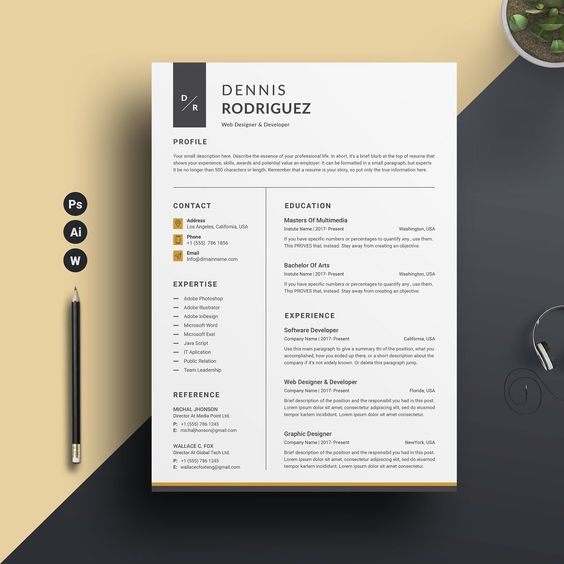
by admin | Mar 19, 2024 | Employment Application, Employee Handbooks, Employee Orientation, Job, Job Analysis
CV Templates In Khmer and English Download
“Discover the perfect blend of professionalism and cultural identity with our CV templates, available for download in both Khmer and English. Whether you’re applying for jobs locally or internationally, our templates are designed to showcase your skills and experiences in the most effective way. Download now and take the first step towards your dream job!”
=> Click the link to Download here: https://drive.google.com/drive/folders/1HjFpRJCUGfNIJVGqACJqW-zsm9u-UH-t?usp=sharing
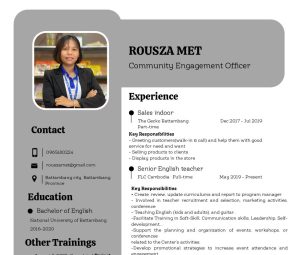

Good Luck!
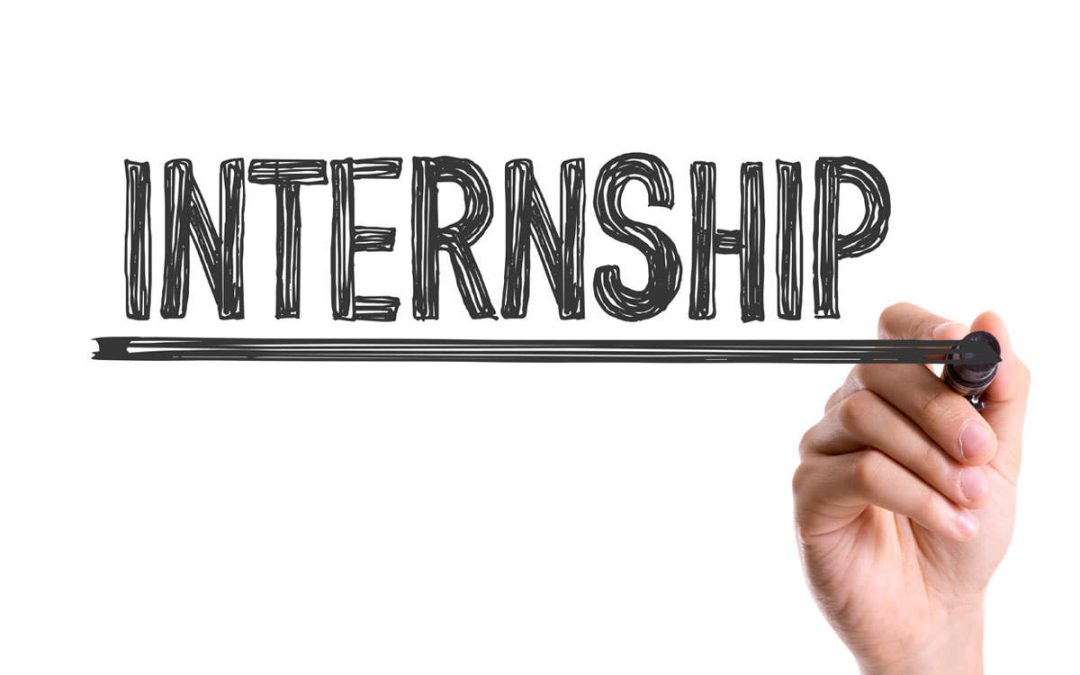
by admin | Mar 18, 2024 | Job, Job Analysis, Skills Gap Analysis, Study
Title: Exploring Opportunities: Finding the Right Internship for You
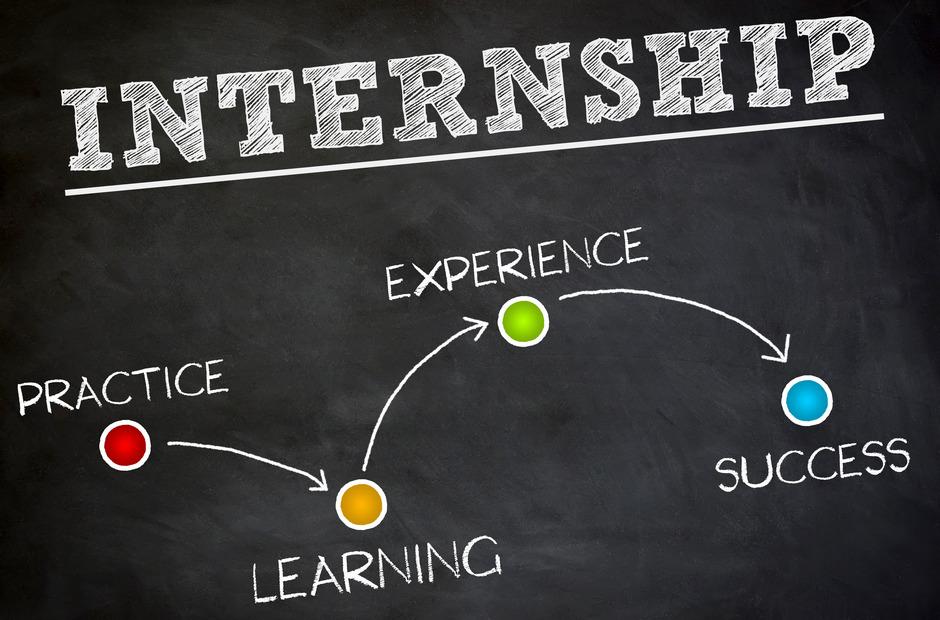
Embarking on an internship journey is an exciting step towards shaping your career path and gaining invaluable real-world experience. However, with countless opportunities available, finding the right internship can feel like navigating a vast ocean. How do you identify the perfect fit amidst a sea of options? Let’s embark on a journey of exploration and discovery to help you find the internship that aligns with your goals, interests, and aspirations.
1. **Define Your Goals and Objectives:**
Before diving into the internship search process, take some time to reflect on your career goals and what you hope to achieve through an internship experience. Consider the skills you want to develop, industries you’re interested in exploring, and the type of work environment that suits you best. Clarifying your objectives will help you narrow down your search and focus on opportunities that align with your aspirations.
2. **Conduct Research:**
Once you have a clear idea of what you’re looking for, it’s time to start researching potential internship opportunities. Explore various companies, organizations, and industries that align with your interests and goals. Utilize online job boards, company websites, professional networks, and career fairs to gather information about internship programs available in your field of interest.
3. **Network and Seek Recommendations:**
Networking is a powerful tool for uncovering hidden internship opportunities and gaining insider insights. Reach out to professionals in your desired industry through networking events, informational interviews, and online platforms like LinkedIn. Don’t hesitate to ask for recommendations or referrals from professors, mentors, or peers who may have connections in your field of interest.
4. **Utilize Career Services:**
Many universities and colleges offer career services and internship placement assistance to students. Take advantage of these resources to access job listings, resume reviews, interview preparation workshops, and career counseling sessions. Career advisors can provide valuable guidance and support throughout the internship search process.
5. **Tailor Your Application Materials:**
Once you’ve identified internship opportunities that interest you, tailor your resume, cover letter, and any other application materials to highlight relevant skills, experiences, and qualifications. Customize each application to align with the specific requirements and preferences of the internship program or organization.
6. **Prepare for Interviews:**
As you start receiving interview invitations, it’s essential to prepare thoroughly to make a positive impression. Research the company, practice common interview questions, and be ready to articulate your interest in the internship and how you can contribute to the organization’s success. Additionally, prepare questions to ask the interviewer to demonstrate your enthusiasm and curiosity.
7. **Evaluate Offers Carefully:**
Congratulations! You’ve received one or more internship offers. Take the time to carefully evaluate each offer based on factors such as the job responsibilities, learning opportunities, company culture, location, and compensation. Consider how each opportunity aligns with your goals and priorities before making a decision.
8. **Stay Flexible and Open-Minded:**
Keep in mind that the internship search process may involve some twists and turns, and you may encounter unexpected opportunities along the way. Stay flexible and open-minded as you explore different options and be willing to adapt your plans based on new information and experiences.
Finding the right internship is a journey of self-discovery and exploration. By defining your goals, conducting thorough research, leveraging your network, and staying proactive, you can uncover exciting internship opportunities that propel you closer to your career aspirations. Remember to approach the process with enthusiasm, curiosity, and a willingness to learn and grow. Your perfect internship awaits – go forth and explore!

by admin | Mar 18, 2024 | Job, Employee Orientation, Employment Application, Interview Techniques, Job Analysis, Skills Gap Analysis
Title: Resume Essentials: What Every Job Seeker Needs to Know
Your resume is your personal marketing tool in the competitive job market. It’s the first glimpse potential employers have into your professional background, skills, and capabilities. Crafting a standout resume requires careful attention to detail and a strategic approach. Whether you’re a recent graduate entering the workforce or a seasoned professional looking for a career change, understanding the essentials of resume writing is crucial. Let’s explore what every job seeker needs to know to create a compelling resume that gets noticed.
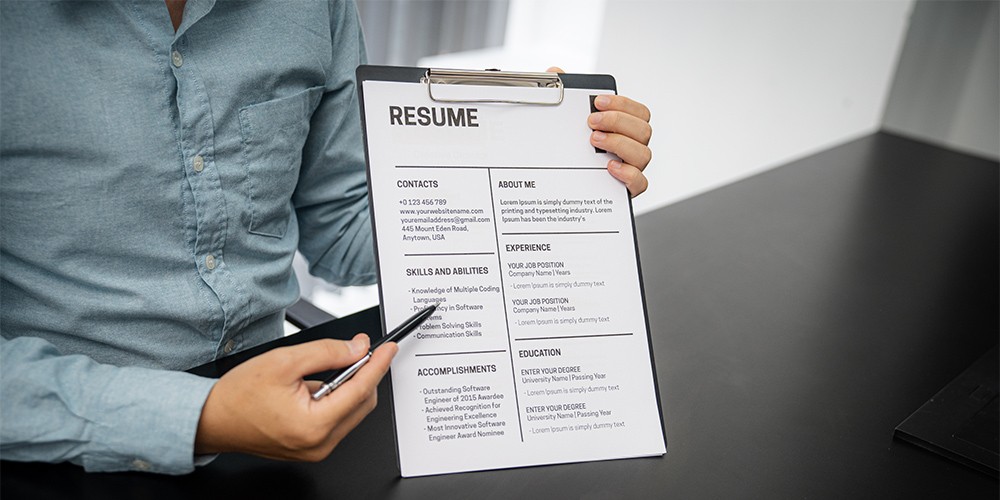
1. Clear Formatting and Layout:
Your resume should have a clean and professional appearance. Use a simple, easy-to-read font and maintain consistent formatting throughout the document. Organize information logically, with clear headings and bullet points to make it easy for recruiters to scan.
2. Contact Information:
Ensure your contact information is prominently displayed at the top of your resume. Include your full name, phone number, email address, and LinkedIn profile (if applicable). Make it easy for recruiters to reach out to you for further consideration.
3. Strong Summary or Objective Statement:
Start your resume with a brief summary or objective statement that highlights your career goals and key qualifications. This section should grab the reader’s attention and provide a snapshot of your professional background and aspirations.
4. Relevant Work Experience:
List your work experience in reverse chronological order, starting with your most recent job. Include the company name, job title, dates of employment, and a brief description of your responsibilities and achievements for each role. Focus on relevant experiences that demonstrate your skills and accomplishments related to the job you’re applying for.
5. Education and Credentials:
Provide details of your educational background, including the name of the institution, degree earned, and graduation date. Mention any relevant certifications, licenses, or professional development courses that enhance your qualifications for the position.
6. Key Skills and Abilities:
Highlight your core skills and competencies that are relevant to the job. This may include technical skills, soft skills, languages, or specialized knowledge relevant to your field. Use keywords from the job description to ensure your resume gets noticed by applicant tracking systems (ATS).
7. Achievements and Accomplishments:
Quantify your achievements whenever possible to demonstrate the impact you’ve made in previous roles. Use specific metrics, such as percentages, dollar amounts, or project milestones, to illustrate your contributions and results.
8. Tailored to the Job Description:
Customize your resume for each job application by aligning your qualifications and experiences with the requirements of the job. Highlight the skills and experiences that are most relevant to the position to increase your chances of getting noticed by recruiters.
9. Proofread and Edit:
Before submitting your resume, carefully proofread it for spelling and grammatical errors. Ensure that all information is accurate and up-to-date. Consider asking a trusted friend, mentor, or professional contact to review your resume for feedback.
10. Keep it Concise:
Aim to keep your resume concise and focused on the most relevant information. Ideally, your resume should be no more than two pages long, with the most important details featured prominently on the first page.
By incorporating these essential elements into your resume, you can create a powerful document that effectively showcases your qualifications and experiences to potential employers. Remember to tailor your resume for each job application and continuously update it as your career progresses. With a well-crafted resume in hand, you’ll be better equipped to land interviews and advance your career goals.

by admin | Mar 18, 2024 | Job, Job Analysis, Skills Gap Analysis
Title: Unlocking Opportunities: Building a Winning Resume

In today’s competitive job market, your resume serves as your first impression to potential employers. It’s your ticket to unlocking opportunities and securing that dream job. But how do you ensure your resume stands out from the crowd? How do you build a winning resume that captures attention and highlights your unique skills and experiences? Let’s delve into the art of crafting a resume that opens doors to new career possibilities.
1. Know Your Audience:
Before you start crafting your resume, it’s essential to understand who will be reading it. Research the company and the role you’re applying for. Tailor your resume to align with the company’s values, culture, and job requirements. This targeted approach shows employers that you’ve taken the time to understand their needs and that you’re the right fit for the position.
2. Highlight Your Achievements:
Instead of simply listing your job responsibilities, focus on your accomplishments. Use quantifiable metrics and specific examples to demonstrate your impact in previous roles. Did you increase sales revenue? Streamline processes to improve efficiency? Lead successful projects? Highlighting your achievements not only showcases your skills but also provides concrete evidence of your value to potential employers.
3. Craft a Compelling Summary:
Your resume summary is your chance to make a strong first impression. Use this section to provide a brief overview of your professional background, skills, and career goals. Make it engaging and relevant to the job you’re applying for. A well-crafted summary can grab the reader’s attention and encourage them to keep reading.
4. Emphasize Relevant Skills:
Identify the key skills and qualifications required for the job, and make sure they’re prominently featured on your resume. Whether it’s technical skills, soft skills, or industry-specific knowledge, highlight the abilities that set you apart from other candidates. Use specific keywords related to the job to ensure your resume gets noticed by applicant tracking systems (ATS) used by many companies.
5. Keep It Concise and Clear:
Recruiters and hiring managers often have limited time to review each resume, so it’s essential to keep yours concise and easy to read. Stick to a clean, professional format with clear headings and bullet points. Use action verbs and concise language to convey your experiences effectively. Aim for a one-page resume whenever possible, focusing on the most relevant information.
6. Proofread and Edit:
Before sending out your resume, take the time to proofread it carefully. Check for spelling and grammar errors, formatting inconsistencies, and any other mistakes that could detract from your professional image. Consider asking a friend or mentor to review your resume as well, as fresh eyes can often catch things you might have missed.
7. Update Regularly:
Your resume is a dynamic document that should evolve as your career progresses. Make it a habit to update your resume regularly, adding new skills, experiences, and achievements as they occur. Even if you’re not actively job searching, keeping your resume up-to-date ensures you’re always prepared for new opportunities that may arise.
By following these tips and strategies, you can create a winning resume that opens doors to exciting career opportunities. Remember to customize your resume for each job application, highlighting the experiences and skills most relevant to the position. With a well-crafted resume in hand, you’ll be well-positioned to unlock new opportunities and take your career to the next level.

by admin | Mar 5, 2024 | Job, Job Analysis, Skills Gap Analysis
Achieving Job Balance: Navigating Work and Life in Harmony
In an era where the lines between work and personal life increasingly blur, achieving job balance has become more crucial than ever. This elusive equilibrium not only enhances productivity and career satisfaction but also improves mental health and personal relationships. This blog explores the concept of job balance, why it’s essential, and practical strategies to navigate work and life in harmony.
Understanding Job Balance
Job balance is not merely about dividing hours between work and personal life; it’s about achieving a state where both aspects complement rather than compete with each other. It’s the ability to fulfill your professional responsibilities while having enough time and energy for personal interests and family. Achieving this balance leads to reduced stress, increased job satisfaction, and overall better quality of life.
The Importance of Job Balance
The significance of job balance cannot be overstated. Constantly tipping the scales towards work can lead to burnout, stress, and health issues. Conversely, neglecting professional responsibilities can result in career stagnation or financial instability. A balanced approach ensures sustained productivity, fosters creativity, and maintains physical and emotional well-being.
Strategies for Achieving Job Balance
1. Set Clear Boundaries: Establish clear limits between work and personal time. This might mean turning off work emails after a certain hour or dedicating weekends solely to family and leisure activities. Clear boundaries prevent work from seeping into every aspect of your life.
2. Prioritize Tasks : Not all tasks are created equal. Identify what’s urgent and important, and allocate your time accordingly. Learning to prioritize effectively can significantly reduce work-related stress and free up time for personal pursuits.
3. Learn to Say No: Overcommitting is a common trap. Be realistic about what you can handle, and don’t be afraid to say no to additional responsibilities if they threaten your ability to maintain balance.
4. Embrace Flexibility: The traditional 9-to-5 model doesn’t fit everyone. If possible, negotiate flexible working hours or remote work options with your employer. Flexibility can be key to balancing work demands with personal needs.
5. Make Time for Yourself: Self-care is not selfish; it’s necessary. Ensure you carve out time for activities that rejuvenate your mind and body, whether it’s reading, exercising, or pursuing a hobby.
6. Leverage Technology Wisely: Technology can be a double-edged sword. Use productivity tools to streamline your work, but be mindful of technology’s tendency to encroach on personal time. Set app limits and designate tech-free zones in your home to disconnect and recharge.
7. Communicate Your Needs: Open communication with your employer about your need for balance is crucial. Many organizations are recognizing the importance of work-life balance and may offer solutions like flexible schedules, mental health days, or support programs.
8. Evaluate and Adjust Regularly: Achieving job balance is an ongoing process. Regularly assess your work-life balance and make adjustments as needed. Life changes, and so will your balancing act.
Conclusion
Achieving job balance is essential for sustaining professional success and personal happiness. It requires conscious effort, clear boundaries, and continuous adjustment. By implementing these strategies, you can navigate the demands of work and life in harmony, leading to a more fulfilling and balanced existence. Remember, balance is not a final destination but a journey that requires constant navigation and adjustment.

by admin | Dec 27, 2023 | Job, Study



Building a personal brand is essential for professional success in today’s competitive landscape. A strong personal brand can set you apart from others in your field, establish your expertise, and open doors to new opportunities. In this blog, we’ll explore key strategies and tips for building and maintaining an effective personal brand.
1. Identify Your Unique Value Proposition
The first step is to understand what makes you unique. This includes your skills, experiences, passions, and values. Ask yourself what you can offer that others in your field cannot. This unique value proposition will be the cornerstone of your personal brand.
2. Define Your Target Audience
Knowing your audience is crucial. Identify who you want to reach with your brand. Are they potential employers, clients, or collaborators in your industry? Understanding your audience will guide your branding efforts and help you tailor your message.
3. Craft Your Personal Story
People connect with stories. Create a compelling narrative about your journey, challenges, successes, and learnings. This story should be authentic and resonate with your target audience, reflecting both your professional path and personal insights.
4. Develop a Consistent Online Presence
In the digital age, your online presence is a significant part of your personal brand. Ensure that your LinkedIn profile, personal website, and social media accounts reflect your professional image consistently. Regularly update these platforms with relevant content and accomplishments.
5. Network Effectively
Building a strong network is key. Attend industry events, join professional groups, and participate in online forums. Networking isn’t just about meeting new people; it’s about building meaningful relationships and exchanging value.
6. Demonstrate Thought Leadership
Establish yourself as a thought leader in your field by sharing insights, writing articles or blog posts, and speaking at events. This showcases your expertise and contributes to the body of knowledge in your industry.
7. Seek Feedback and Evolve
Your personal brand should evolve as you grow professionally. Regularly seek feedback from mentors, colleagues, and your network. Use this feedback to refine your brand and stay relevant in your field.
8. Maintain Professionalism
Always exhibit professionalism in your interactions, both online and offline. Your behavior and communication should consistently reflect the values and image of your personal brand.
9. Be Authentic
Authenticity is key to a successful personal brand. Be true to yourself and your values. Authenticity fosters trust and builds stronger connections with your audience.
10. Give Back to Your Community
Contribute to your industry or community. This could be through mentoring, volunteering, or supporting causes related to your field. Giving back not only enriches your personal brand but also helps build a supportive professional community.
Conclusion
Building a personal brand is an ongoing process that requires reflection, consistency, and adaptation. By following these steps, you can develop a strong personal brand that aligns with your professional goals and resonates with your audience. Remember, your personal brand is a reflection of who you are and how you wish to be perceived in the professional world. Make it count!













